Description
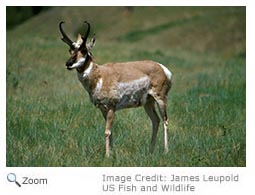 The pronghorn is a unique North American mammal. Its Latin name, Antilocapra americana, means "American goat-antelope," but it is not a member of the goat or the antelope family and it is not related to the antelopes found in Africa. The pronghorn is the only surviving member of the Antilocapridae family and it has been in North America for over a million years! The pronghorn is a unique North American mammal. Its Latin name, Antilocapra americana, means "American goat-antelope," but it is not a member of the goat or the antelope family and it is not related to the antelopes found in Africa. The pronghorn is the only surviving member of the Antilocapridae family and it has been in North America for over a million years!
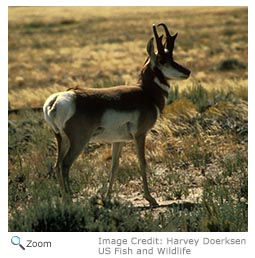 The pronghorn has a deer-like body. It weighs between 90 and 120 pounds and stands about 3.5 feet tall from shoulder to feet. It has a tan to reddish brown body. Its cheeks, belly, rump, chest, and inner legs are white. Males have a broad, black mask that runs from their eyes down their snout to their nose; black neck patches; and pronged black horns that are 12-20 inches long. The male's horns are lyre-shaped and curve in towards each other. The pronghorn has a deer-like body. It weighs between 90 and 120 pounds and stands about 3.5 feet tall from shoulder to feet. It has a tan to reddish brown body. Its cheeks, belly, rump, chest, and inner legs are white. Males have a broad, black mask that runs from their eyes down their snout to their nose; black neck patches; and pronged black horns that are 12-20 inches long. The male's horns are lyre-shaped and curve in towards each other.
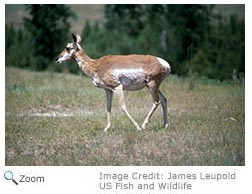 The female does not have the black markings and her horns are usually straight, short spikes between 3-4 inches long. The pronghorn has horns, not antlers. Its horns are made of two parts: a bony core and a sheath-like covering made of a stiff hair-like material. It is the only animal that has branched horns, and it is the only animal that sheds its horns each year. The outer sheath falls off every year in the fall and then grows back in the summer. The female does not have the black markings and her horns are usually straight, short spikes between 3-4 inches long. The pronghorn has horns, not antlers. Its horns are made of two parts: a bony core and a sheath-like covering made of a stiff hair-like material. It is the only animal that has branched horns, and it is the only animal that sheds its horns each year. The outer sheath falls off every year in the fall and then grows back in the summer.
Range
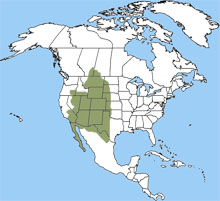 The pronghorn can be found in southeastern Oregon; southern Idaho; southern Saskatchewan and Alberta, Canada; Montana; and western North Dakota south to Arizona and western Texas. The pronghorn can be found in southeastern Oregon; southern Idaho; southern Saskatchewan and Alberta, Canada; Montana; and western North Dakota south to Arizona and western Texas.
Habitat
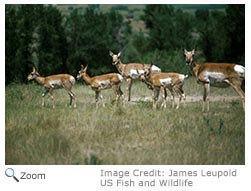 The pronghorn lives in grasslands, brushlands, and deserts. The pronghorn lives in herds that change in size depending on the season. In the summer, females and their young will gather in bands of less than a dozen individuals. Young males less than two years old form bachelor herds. Breeding males establish individual territories. In the winter, the herd will include males and females and can include hundreds of pronghorns. The pronghorn migrates from a summer feeding ground to a winter feeding ground. The pronghorn lives in grasslands, brushlands, and deserts. The pronghorn lives in herds that change in size depending on the season. In the summer, females and their young will gather in bands of less than a dozen individuals. Young males less than two years old form bachelor herds. Breeding males establish individual territories. In the winter, the herd will include males and females and can include hundreds of pronghorns. The pronghorn migrates from a summer feeding ground to a winter feeding ground.
Diet
 In the summer, the pronghorn grazes on grasses, forbs and cactus. In the winter, the pronghorn eats sagebrush and other available plants. In the summer, the pronghorn grazes on grasses, forbs and cactus. In the winter, the pronghorn eats sagebrush and other available plants.
|
|
Life Cycle
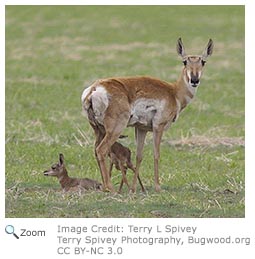 In the southern part of their range, pronghorns mate in the late summer. In the northern part of their range, they mate in the early fall. Males will fight over females. A male may mate with more than one female. The female gives birth to one to two fawns in late May or early June. In the southern part of their range, pronghorns mate in the late summer. In the northern part of their range, they mate in the early fall. Males will fight over females. A male may mate with more than one female. The female gives birth to one to two fawns in late May or early June.
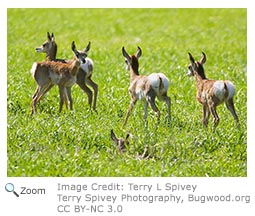 The fawns are almost odorless at birth. This helps protect them from predators. They will stay hidden in the grass for the first few days. Their mother will graze away from where she has hidden her fawns so that she doesn't attract predators to where they are hidden. The fawns join the herd when they are about a week old, and they begin grazing when they are three weeks old. They can run faster than a human when they are just four days old! The fawns are almost odorless at birth. This helps protect them from predators. They will stay hidden in the grass for the first few days. Their mother will graze away from where she has hidden her fawns so that she doesn't attract predators to where they are hidden. The fawns join the herd when they are about a week old, and they begin grazing when they are three weeks old. They can run faster than a human when they are just four days old!
Behavior
 The pronghorn is the fastest animal in the Western Hemisphere. It can run at speeds of up to 60 miles per hour, and it can run long distances at speeds of 30-40 miles per hour. It can make bounds of up to 20 feet when it is running. When the pronghorn runs, its mouth is open so it can breath in extra oxygen. Speed is important because the pronghorn lives in open areas, and there is no place to hide from a predator! It has to be able to run away! The pronghorn is the fastest animal in the Western Hemisphere. It can run at speeds of up to 60 miles per hour, and it can run long distances at speeds of 30-40 miles per hour. It can make bounds of up to 20 feet when it is running. When the pronghorn runs, its mouth is open so it can breath in extra oxygen. Speed is important because the pronghorn lives in open areas, and there is no place to hide from a predator! It has to be able to run away!
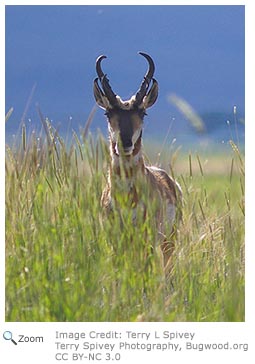 The pronghorn is active in the night and in the day. It has excellent eyesight and can spot a threat up to four miles away! When the pronghorn is threatened, it may attack with its sharp hooves. The pronghorn is active in the night and in the day. It has excellent eyesight and can spot a threat up to four miles away! When the pronghorn is threatened, it may attack with its sharp hooves.
Video Credit: US Fish and Wildlife
|

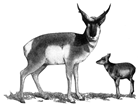



 The pronghorn can be found in southeastern Oregon; southern Idaho; southern Saskatchewan and Alberta, Canada; Montana; and western North Dakota south to Arizona and western Texas.
The pronghorn can be found in southeastern Oregon; southern Idaho; southern Saskatchewan and Alberta, Canada; Montana; and western North Dakota south to Arizona and western Texas.





